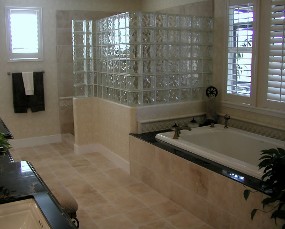Bathroom Floor Tile Guide
Updating your bathroom floor tile can transform your bathroom into a spa oasis. Tile flooring materials such as marble, travertine, limestone, granite, slate, ceramic and porcelain all work to create a fresh look and function well as bathroom flooring.
Generally, you can find any size tile from 1 x 1 inch mosaic tile up to 24 x 24 inch tiles in any material.
Modern floor tile comes in so many colors, patterns and textures that bathroom tile design is really limitless.
Maybe too limitless... making it hard to decide what to do and what kind of tile to choose.
Well, I'll give you some direction by outlining the different tile flooring materials, what to avoid and special considerations to help you make the best decision for your project.
Stone Tile

Granite
Granite tiles are a great stone to use in any room. It's infinitely durable, easy to care for and comes in thousands of colors.
The only real issue with granite in a bathroom is the finish.
Most often granite is polished to bring out the color and depth of pattern, but in a bathroom polished granite will be very slick unless you use smaller (4x4 inch) granite tiles.
When using larger tiles, make sure the surface is honed or otherwise not polished.
Marble, Travertine, Limestone
These stones are simply classic for bathroom floor tile. Their soft warm tones make for a cozy space and patterns ranging from subtle to dramatic will suit many design themes.
A honed or tumbled finish is most common providing an appealing texture and great traction. The only issue with limestone, marble and travertine floor tile is etching.
Etching is a chemical reaction that occurs when calcite based stones come in contact with acidic or alkaline foods or products.
Acidic foods in the bathroom is not much of a problem, but alkaline cleaning products can be.
I recommend using only products formulated to be safe for cleaning marble, travertine and limestone.
Slate Tile
Slate has a unique and somewhat masculine look that is often desired as a bathroom floor tile. It's an interesting stone that comes in more than just gray-green... purples, golds and reds can be found too.
But slate has some potentially large undesirable issues.
The problem with slate is the quality of the stone. You may get slate tile that is very durable and will last for a long-time or you could get a variety that will be constantly breaking apart and crumbling.
For this reason, slate is really not recommended for wet or heavily used environments. Also, slate etches like marble, so it must be cleaned and maintained with products for stone only.
Ceramic & Porcelain
Porcelain and ceramic floor tile cousins. Made in essentially the same way, they share similar qualities. Both are water-proof, durable and very easy to care for with no special products required.
Both ceramic and porcelain floor tile come in a wide range of colors and patterns with different types of non-slip surface suitable for a bathroom. Ceramic tile flooring and porcelain differ in composition. Porcelain is made with more feldspar and less clay making porcelain harder, more scratch and chip resistant and ultimately longer-lasting.
You can expect porcelain to last as long as stone, which is as long as the house is standing! Also, porcelain can be "full-bodied" with consistent color all the way through the tile making for easier repairs.
Porcelain also offers greater variety in colors and patterns with good imitations of travertine and glass tile, but ceramic tile is less expensive and easier to install.
Sealing Bathroom Floor Tile
Sealing stone is a controversial issue. Lots of confusion surrounds the question of sealing bathroom floor tile. Most of it centers on stone, but some porcelain and ceramic tile need sealing.
Manufacturers recommend that polished porcelain be sealed. (NOTE: this is the opposite of polished marble/travertine, which typically does not need sealing.)
Well, it's not a good idea to install a polished surface in a bathroom, so sealing porcelain is not likely an issue in this case. All other porcelain surfaces do not require sealing.
Unglazed ceramic needs sealing, but most ceramic floor tile will be glazed and most glazed ceramic tiles are non-slip surfaces, so again not much to worry about with ceramic.
But what about granite, marble, travertine, etc? Well, some will say that you should seal these stones, especially since they are most commonly not polished in the bathroom and thus more porous.
Here's the deal: The reason you seal a porous surface is to diminish the absorbency of the material and the chance of a stain. This is very important in rooms where there's a lot of food and drink like the kitchen.
Not much food or drink in the bathroom. Occasionally yes.... but the risk of staining the floor or a shower is so small that you don't gain much by sealing (a countertop is a different issue). If it's a high-traffic bathroom, go a ahead and seal the tile flooring, but you don't have to.
You still have a ways to go...
I know.... take a look around this site and you'll find plenty of
additional information to help you design and plan your bathroom floor tile project.



